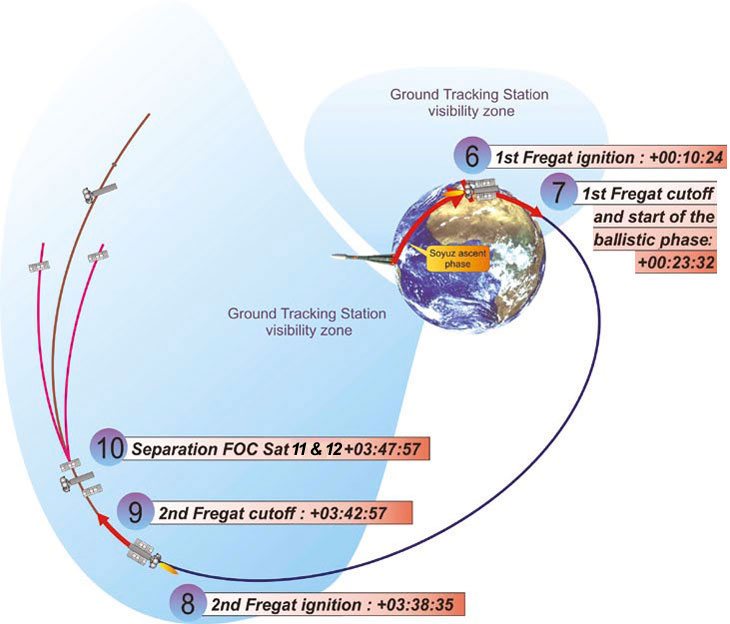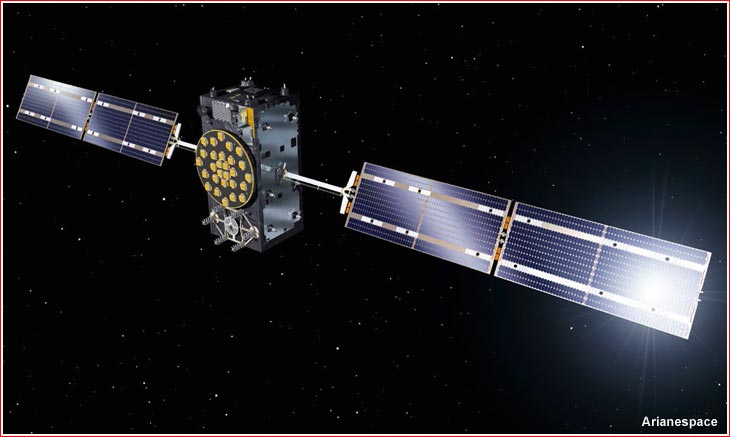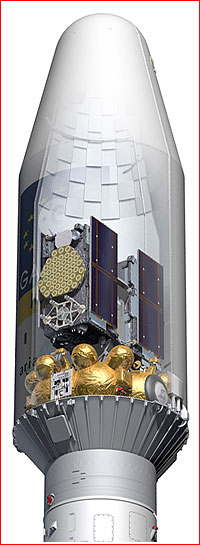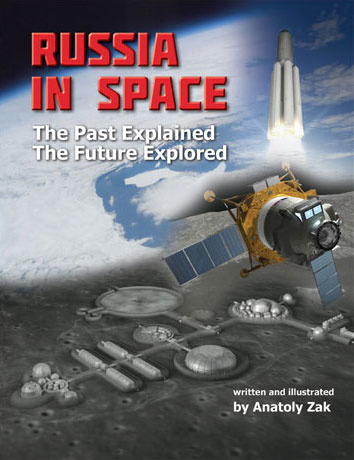Soyuz VS13 launch with Galileo FOC M4 satellites (original) (raw)
Soyuz completes its eighth mission with Galileo satellites
On December 17, 2015, a Soyuz rocket lifted off from its launch pad in Kourou, French Guiana, successfully delivering the fourth pair of fully operational Galileo satellites, known as FOC-M4. Being the 13th launch of the Russian-built rocket from its South-American launch pad, the mission had a designation VS13.
Previous Galileo launch: VS12 FOC-M3

Soyuz rocket lifts off from its launch pad in French Guiana on Dec. 17, 2015, with a pair of Galileo satellites.
From the publisher: Pace of our development depends primarily on the level of support from our readers!
Eighth Galileo mission (VS13) in December 2015
The liftoff of the Soyuz-ST-B/Fregat-MT rocket from the ELS pad near Kourou, French Guiana, took place as scheduled on Dec. 17, 2015, at 8:51:56 a.m. local time in French Guiana (6:51 a.m. EST). (It was 11:51 GMT and 14:51 Moscow Time.) The 13th Soyuz launch from Guiana (under designation VS13) carried a total of 1,603 kilograms of payload, including a pair of Galileo FOC-M4 satellites and a dispenser built by RUAG Space. The same company also supplied the ST fairing covering the payload during the initial phase of the flight.
These were the seventh and eighth FOC (Full Operational Capability) spacecraft in Europe’s Galileo navigation program. However counting four In-orbit Validation, IOV, satellites, which were also pressed into operational service, they became the 11th and 12th spacecraft in the operational Galileo constellation.
Following this Soyuz launch, the deployment of the Galileo constellation will shift to the heavier Ariane-5 ES rocket, carrying four satellites at a time. As of December 2015, the first Ariane-5 mission with a Galileo quartet was expected in the second half of 2016. Soyuz is still expected to fly one Galileo mission in 2017 and four more launches are considered for 2019 and 2020. The same rocket could also be used to launch 2nd-generation satellites beginning in 2025.
The VS13 mission will be the unprecedented 12th orbital launch attempt during the year for Arianespace, counting six Ariane-5 and three Vega launchers, which this European company also operates from ELA-3 and ELA-1 pads in Kourou, French Guiana.
Soyuz VS13 mission with Galileo satellites at a glance:
| Payloads | Galileo FOC M4, Sat 11, FM08 Andriana, Galileo FOC M4, Sat 12, FM09 Liene |
|---|---|
| Spacecraft liftoff mass | 717 kilograms and 717.5 kilograms |
| Total payload liftoff mass | 1,603 kilograms |
| Orbital plane in the Galileo constellation | Plane C |
| Orbital altitude | 23,222 kilometers |
| Orbital inclination toward the Equator | 54.946 degrees |
| Launch vehicle | Soyuz-ST |
| Launch site | French Guiana, ELS |
| Launch date and time | 2015 Dec. 17, 11:51:56 UTC |
| Duration of orbital insertion | 3 hours 47 minutes 57 seconds |
Flight profile

Initial launch profile of the Soyuz-ST rocket (mission VS13) with Galileo FOC-M4 satellites in December 2015. Credit: Arianespace

Mission profile of the Soyuz-ST rocket (mission VS13) with Galileo FOC-M4 satellites in December 2015. Credit: Arianespace
According to Arianespace, which manages this mission for the European Space Agency, ESA, the powered phase of the first, second and third stages on Soyuz was to last about nine minutes. The third stage of the launcher will then be separated from the upper composite, comprising the Fregat upper stage and the two satellites. The three lower stages and the fairing were to fall back into the sea.
After a first burn, the upper composite is spun up during a ballistic phase lasting about three hours and 15 minutes. Then, Fregat will ignite its own engine to bring the upper composite to a transfer orbit over the Earth. At a pre-determined point of this orbit, Fregat will ignite for a second burn lasting four minutes to reach the circular orbit of separation. At the end of the mission, the Fregat upper stage will be emptied of any remnants of its pressurized contents and deactivated.
The entire orbital insertion process is expected to conclude three hours, 47 minutes and 57 seconds after the liftoff with the release of the satellites into a 23,222-kilometer orbit with an inclination 54.946 degrees toward the Equator.
The satellites will later use their own propulsion system to lower their altitude in order to enter their operational orbit in the Orbital Plane C of the Galileo constellation.
Preparations for launch
Galileo satellites No. 11 and No. 12 arrived to French Guiana on Nov. 2, 2015, aboard a transport plane, landing at Félix Eboué International Airport near Cayenne. The pair was then transported to the S1 facility in Kourou for checkout.
By December 8, the satellites were integrated with their payload dispenser inside the S3B facility in Kourou. By December 11, in the same building, the composite was attached to its Fregat upper stage.
The Soyuz-ST rocket was rolled out from its integration building to the launch pad on Dec. 14, 2015. The next day, the upper composite including the satellites, the Fregat and the payload fairing were also brought to the pad, hoisted to the top of the rocket and integrated with the rest of the launch vehicle.

Soyuz rocket for the VS13 FOC-M4 mission arrives at its launch pad in French Guiana on Dec. 14, 2015.
Galileo FOC-M3 launch sequence on Sept. 10, 2015:
| PRE-LAUNCH EVENTS | Time (h:min:sec) |
|---|---|
| Beginning of the State Commission meeting for launcher fueling authorization | -05:00:00 |
| Beginning of Launch Vehicle fueling with propellant components | -04:30:00 |
| Launch Vehicle is fueled with all propellant components | -01:35:00 |
| Mobile gantry withdrawal | -01:10:00 |
| Key on start (beginning of Soyuz synchronized sequence) | -00:05:10 |
| Fregat transfer to onboard power supply | -00:05:00 |
| Upper Composite umbilical drop off command | -00:02:25 |
| Ground-board power transfer | -00:00:40 |
| Lower stage mast retraction | -00:00:28 |
| Ignition | -00:00:17 |
| Preliminary thrust level | -00:00:15 |
| Full thrust level | -00:00:03 |
| LAUNCH EVENTS | - |
| Lift-off | 00:00:00 |
| Jettisoning of 1st stage boosters at an altitude of 45 kilometers | 00:01:58 |
| Jettisoning of fairing | 00:03:29 |
| Separation of the core (2nd) stage at an altitude of 150 kilometers | 00:04:48 |
| Separation of the 3rd stage | 00:09:24 |
| Fregat 1st burn starts | 00:10:24 |
| Fregat 1st burn ends | 00:23:32 |
| Fregat 2nd burn starts | 03:38:35 |
| Fregat 2nd burn ends | 03:42:57 |
| Separation of FOC-M3 No. 11 and No. 12 into Orbital Plane C of the Galileo constellation | 03:47:57 |
Galileo FOC satellites

The current Galileo satellites are built by Bremen-based OHB System as prime contractor, with their navigation payloads provided by Surrey Satellite Technology Ltd. UK, a 99%-owned subsidiary of Airbus Defense and Space. The two spacecraft to be orbited by Arianespace on Flight VS13 will be the seventh and eighth OHB-built satellites.
Known specifications of Galileo FOC-M4 Sat 11 FM08 Andriana and Sat 12 FM09 Liene:
| Customer | ESA (European Space Agency) |
|---|---|
| Contractors | OHB-System (satellite bus and a prime contractor) SSTL (payload) |
| Total mass at lift-off | 717 kilograms and 717.5 kilograms |
| Dimensions | 2.7 by 1.2 by 1.1 meters and 14,67 meters solar panels span when deployed in orbit |
| Life span | More than 12 years |
| On-board power | 1,900 Watts |
| Navigation signal | 3 bands (E5, E6 and E1) |
| Additional payload | COSPAS-SARSAT search and rescue transponder |
Read much more about the history of the Russian space program in a richly illustrated, large-format glossy edition:
The article by Anatoly Zak; Last update:December 17, 2015
All rights reserved
IMAGE ARCHIVE




Soyuz-ST-B rocket lifts off on the VS13 mission on Dec. 17, 2015. Credit: ESA


)